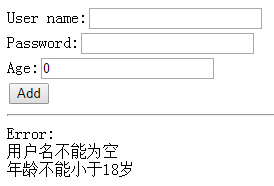Spring MVC使用InitBinder验证:
使用InitBinder做验证的情况一般会在此Controller中提交的数据需要有一些是业务性质的,也即比较复杂的验证情况下才会使用。大部份简单的表单验证,使用annotation验证即可以解决。
Annotation验证使用方法可参见:http://www.cnblogs.com/HD/p/4123146.html
这里需要注意的一点:InitBinder和Annotation两种验证只能二选一,如果使用了InitBinder,就不能使用Annotation验证。
前面的web.xml和spring.xml的配置就不再重复,可参见上面链接中的配置。一模一样。
直接上代码:
1、User5 model实体类
package com.my.controller.bean; import java.util.Date; public class User5 { private long id; private String name; private String password; private Date createTime; private int age; public long getId() { return id; } public void setId(long id) { this.id = id; } public String getName() { return name; } public void setName(String name) { this.name = name; } public String getPassword() { return password; } public void setPassword(String password) { this.password = password; } public Date getCreateTime() { return createTime; } public void setCreateTime(Date createTime) { this.createTime = createTime; } public int getAge() { return age; } public void setAge(int age) { this.age = age; } }
2、新增一个Validator:
package com.my.controller.validator; import org.springframework.stereotype.Component; import org.springframework.validation.Errors; import org.springframework.validation.ValidationUtils; import org.springframework.validation.Validator; import com.my.controller.bean.User5; @Component public class TestValidator implements Validator { @Override public boolean supports(Class<?> paramClass) { return User5.class.equals(paramClass); } @Override public void validate(Object obj, Errors errors) { User5 user = (User5) obj; ValidationUtils.rejectIfEmptyOrWhitespace(errors, "name", "valid.name", null, ""); if(user.getAge() < 18) { errors.rejectValue("age", "valid.ageMin", new Object[]{"age" ,18}, "年龄不能小于{1}岁"); } } }
这里需要加入@Component,注入DI
3、Controller
package com.my.controller; import java.util.LinkedHashMap; import java.util.List; import java.util.Map; import javax.validation.Valid; import org.springframework.beans.factory.annotation.Autowired; import org.springframework.beans.factory.annotation.Qualifier; import org.springframework.stereotype.Controller; import org.springframework.validation.BindingResult; import org.springframework.validation.FieldError; import org.springframework.validation.Validator; import org.springframework.web.bind.WebDataBinder; import org.springframework.web.bind.annotation.InitBinder; import org.springframework.web.bind.annotation.ModelAttribute; import org.springframework.web.bind.annotation.RequestMapping; import org.springframework.web.bind.annotation.RequestMethod; import org.springframework.web.servlet.ModelAndView; import com.my.controller.bean.User5; @Controller @RequestMapping(value="binder") public class TestInitBinderController { @Autowired @Qualifier(value="testValidator") private Validator validator; @InitBinder private void initBinder(WebDataBinder binder) { binder.setValidator(validator); } @RequestMapping(method=RequestMethod.GET) public String index() { return "/TestInitBinder/index"; } @RequestMapping(value="add", method=RequestMethod.POST) public ModelAndView add(@ModelAttribute @Valid User5 user, BindingResult result) { ModelAndView view = new ModelAndView("TestInitBinder/index"); view.addObject("user", user); if(result.hasErrors()) { List<FieldError> errs = result.getFieldErrors(); Map<String, String> mapErrors = new LinkedHashMap<String, String>(); for(FieldError err : errs) { System.out.println("ObjectName:" + err.getObjectName() + " FieldName:" + err.getField() + " FieldValue:" + err.getRejectedValue() + " Message:" + err.getDefaultMessage()); mapErrors.put(err.getField(), err.getDefaultMessage()); view.addObject("errors", mapErrors); } return view; } return view; } }
把Validator注入到Controller中。
事实上,使用InitBinder,在add controller中的err.getDefaultMessage()方法是取不到对应正确的message的。可以看最后的输入打印结果。
4、View
<%@ page language="java" contentType="text/html; charset=UTF-8" pageEncoding="UTF-8"%> <%@ taglib uri="http://java.sun.com/jsp/jstl/core" prefix="c" %> <%@ taglib uri="http://java.sun.com/jsp/jstl/fmt" prefix="fmt"%> <%@ taglib uri="http://java.sun.com/jsp/jstl/functions" prefix="fn" %> <%@ taglib prefix="st" uri="http://www.springframework.org/tags" %> <%@ taglib prefix="form" uri="http://www.springframework.org/tags/form"%> <!DOCTYPE html PUBLIC "-//W3C//DTD HTML 4.01 Transitional//EN" "http://www.w3.org/TR/html4/loose.dtd"> <html> <head> <meta http-equiv="Content-Type" content="text/html; charset=UTF-8"> <title>Init binder</title> </head> <body> <form:form action="/TestSpringMvc1/binder/add" method="post" modelAttribute="user5"> User name:<input type="text" id="name" name="name" value="${user.name}" /><br/> Password:<input type="text" id="password" name="password" value="${user.password}" /><br/> Age:<input type="text" id="age" name="age" value="${user.age}" /><br/> <input type="submit" value="Add"/> <hr/> Error:<br/> <form:errors path="*"></form:errors> </form:form> </body> </html>
注意,这里只能使用<form:errors />来取得错误信息,且,这个<form:errors/>一定要在<form:form/>当中。
5、结果测试

点击Add button:

打印输出:

可以看到,这里取不到错误的正确信息
事实上,在一个非常复杂表单页面,里头所提交的数据验证有一定的业务逻辑性时,InitBinder应该都不多用,因为很多时候我们可以使用一个Map,把errors插入进去,在页面读取即可。比如:
Map<String, String> errors; errors.add("name", "user name can NOT be empty!"); : :
页面中只需要使用:
<span style="color:red;">${errors.name}<span>
即可。